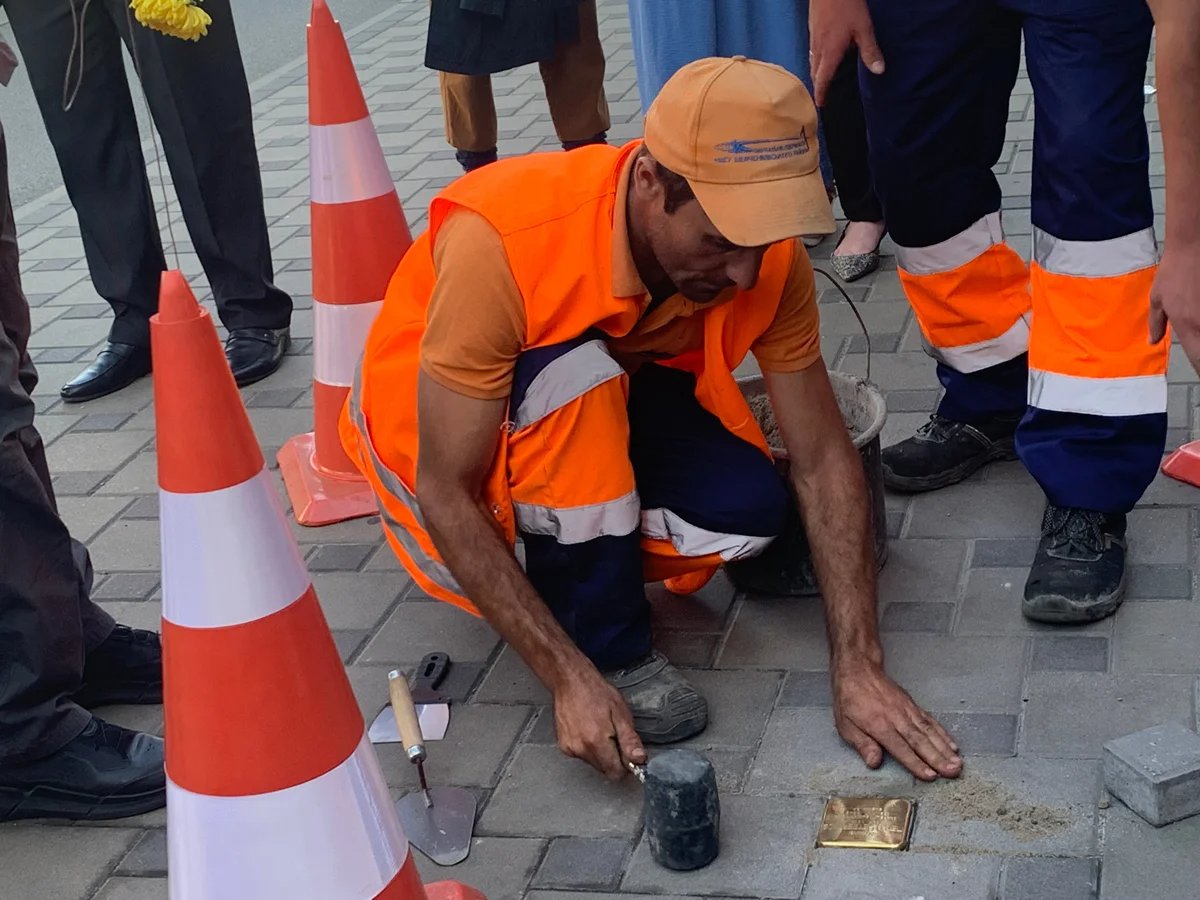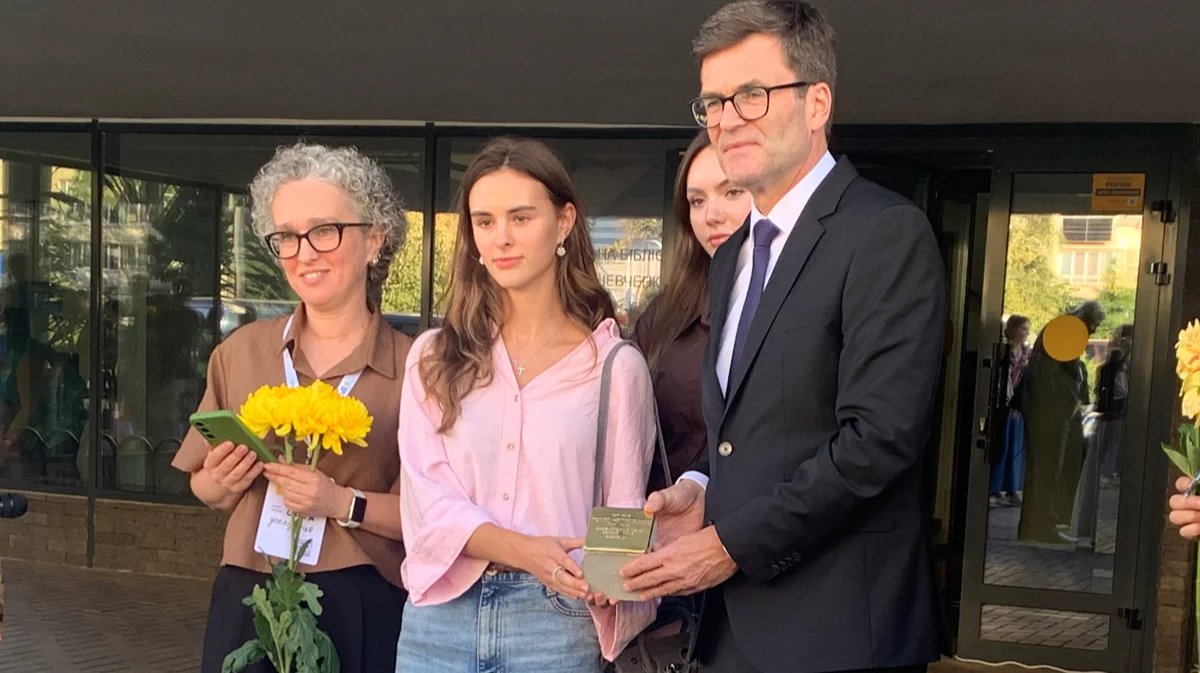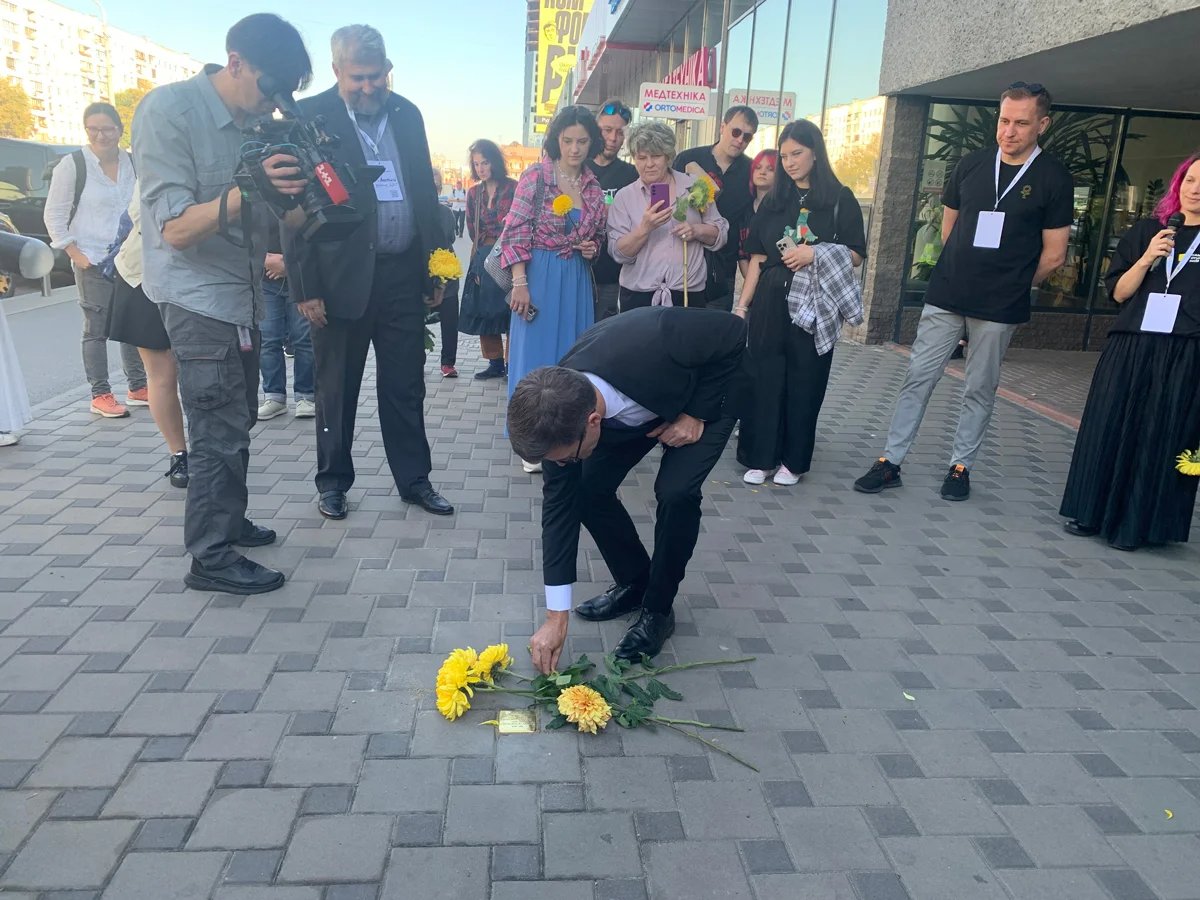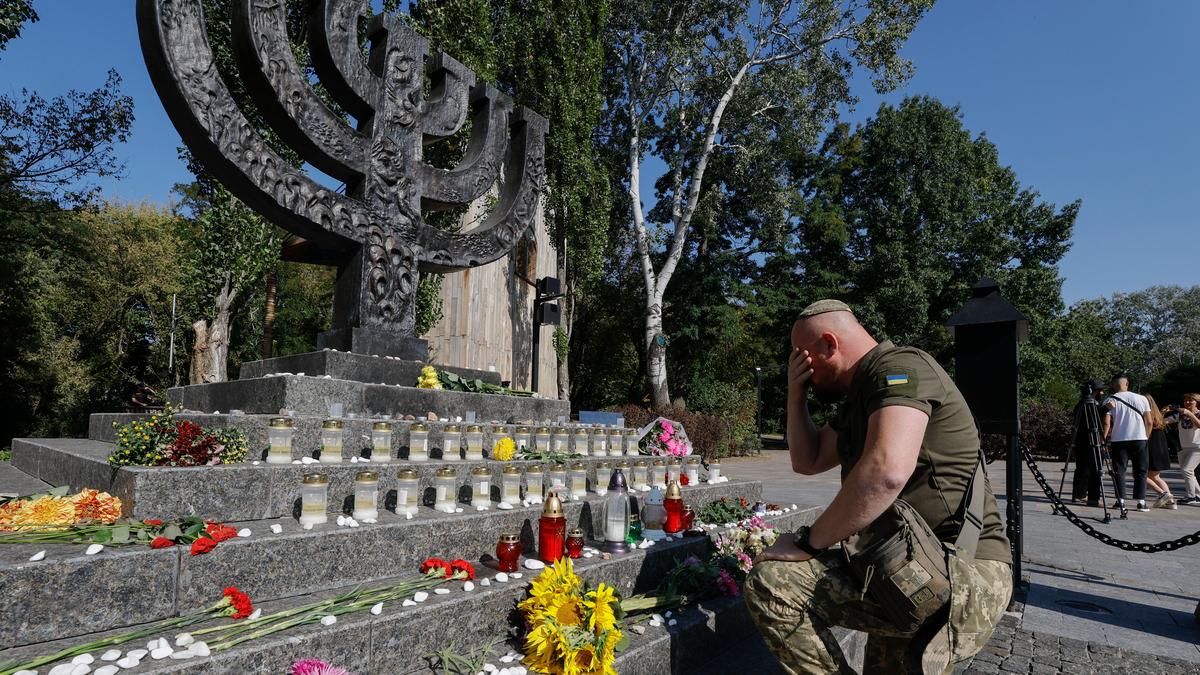“If, dear friends, an air alert sounds, we’ll suspend the ceremony and quickly move to the nearest air raid shelter. OK?” says the organiser, gesturing towards a nearby metro station, an eventuality everybody present has long since become accustomed to.
We are gathered in Kyiv for a ceremony to lay a so-called Stolperstein in honour of an anti-fascist underground member named Petro Chetverikov. Founded by German artist Gunter Demnig in 1992, the international art project Stolperstein — German for stumbling block — has resumed its work in Kyiv after a three-and-a-half year forced suspension of its activities due to the war.
The project produces small concrete cubes with brass plaques to commemorate those who died in the Holocaust, embedding them into the pavement outside the homes of those who were murdered by the Nazis. By informing passersby of the victims’ names, dates of birth, arrest, deportation, and death — if known — the project hopes to encourage people to reflect for a minute on the brutal 20th century history hidden in plain sight on streets throughout Europe.
When the Nazis came for her, Mrs Osipov handed her 1-year-old daughter Irit to Babych as she was led away in a column to be shot.
Demnig’s is the world’s largest decentralised memorial project, with blocks now laid all over Germany, as well as in Austria, Argentina, Belgium, Czechia, France, Greece, Israel, Italy, Netherlands, Spain, Poland and the US. They now number over 100,000, though the number of those still waiting to be memorialised is still much greater.
The first blocks in Ukraine appeared in the cities of Pereiaslav in 2011 and Rivne in 2018. One of those in Rivne honours the memory of Maria Babych, who worked as a nanny for the Jewish Osipov family. When the Nazis came for her, Mrs Osipov handed her 1-year-old daughter Irit to Babych as she was led away in a column to be shot. Some 17,500 Jews died — half the population of Rivne at the time.
Babych, who was 50 at the time, relocated multiple times, realising that if she was exposed, both she and the child she was attempting to pass off as her own daughter would be killed. After the war, Irit’s father returned from the front and found both his daughter and the woman who had saved her. In 1949, the Osipovs emigrated to Israel and took Babych with them as a cherished member of the family. She was the first Ukrainian woman to be awarded the title of “righteous among the nations” by Israeli Prime Minister Golda Meir.

A workman embeds a Stolperstein into the pavement in Kyiv, Ukraine, 23 September 2025. Photo: Olga Musafirova
In the autumn of 2021, on the 80th anniversary of the Nazi atrocities at Babyn Yar, a ravine outside Kyiv where one of the largest mass shootings of Jews in German-occupied Europe took place in September 1941, the Ukrainian Centre for Holocaust Studies launched a project in conjunction with Solidarity Space, an educational centre, and the Kyiv authorities, to lay 80 Stolpersteine in Kyiv honouring both victims of the atrocity and non-Jewish Ukrainians who risked their lives to save those of their Jewish friends and neighbours.
As part of that project, a Stolperstein dedicated to Liudmyla Tkach was placed near her former home in Kyiv’s Podil district. The then-4-year-old and her mother were taken to be shot at Babyn Yar, but jumped into the pit before the firing squad began to shoot, and managed to play dead among the corpses until night fell when they crawled out, becoming two of the 29 people documented to have survived the massacre.
The missiles Russia uses in its relentless attacks on Kyiv spare neither the living nor the dead. The Babyn Yar Historical and Memorial Reserve was first damaged on 1 March 2022, in the earliest days of the invasion. In broad daylight, the Russians targeted the city’s TV tower, but hit the old Jewish cemetery instead, killing five people, including a child.

German Ambassador Heiko Thoms attends the Stolperstein-laying ceremony in Kyiv, Ukraine, September 23, 2025. Photo: Olga Musafirova
Russian shelling in early 2024 disturbed the ashes of the victims once again when a missile exploded near the site of the Nazi executions. Babyn Yar came into the Russian army’s crosshairs for a third time on 31 July, during one of the biggest and most ferocious overnight airstrikes on Kyiv, involving over 300 kamikaze drones and eight Iskander missiles. One drone littered the Alley of the Righteous with debris.
Such is the prologue to the event that took place outside the Shevchenko Central Children’s Library last week. The organisers chose to hold the event between Rosh Hashanah, the Jewish New Year, and the anniversary of the massacre at Babyn Yar on 29 September.
Another cube waiting to be placed in among the cobblestones near the children’s library is dedicated to Petro Chetverikov, whose role in saving Jewish lives was documented in archival research carried out by students from the Kyiv Polytechnic Institute. You won’t find anything about this Chetverikov on Wikipedia.
An active participant in the Soviet anti-fascist underground, Chetverikov and his wife Maria hid a Jewish orphaned teenage girl in a private house where members of the underground met in 1941, before transporting her to a village where friends of theirs adopted her.
Later, the Chetverikovs sheltered another girl who had miraculously escaped a German raid, and transported her to a partisan detachment. Chetverikov was arrested by the Gestapo in 1943 and was himself shot at Babyn Yar, which continued to be used as a site for Nazi executions after the original massacre.
“Modern Germany has managed to overcome the terrible legacy of National Socialism, and repented to humanity. And we stand together today,” said Anatoliy Podolskyi, director of the Ukrainian Centre for Holocaust Studies, addressing the German ambassador to Ukraine.
I noticed a soldier going down on one knee in the sea of yellow flowers — chrysanthemums, dahlias, even sunflowers — that even covered the small brass plaque.
“I apologise for speaking in German,” Ambassador Heiko Thoms began in turn. It sounded particularly weighty given the context. “I promise that by the time the next block is laid in Kyiv, I will speak some Ukrainian.”
Thoms, a new arrival in Kyiv who had presented his credentials to Ukraine’s Foreign Ministry just days earlier, continued: “This is more than just a ritual in memory of the victims of Babyn Yar. It is about acceptance. Germany bears the burden of … responsibility for its past crimes, for the black pages of German history — the murders of Jews, Roma, prisoners of war, Ukrainian rebels… We remember the lesson we have learnt.”

The German Ambassador Heiko Thoms lays flowers at a Stolperstein-laying ceremony in Kyiv, Ukraine, 23 September 2025. Photo: Olga Musafirova
“Today’s event is the first of its kind since the beginning of Russia’s large-scale aggression, which is ongoing and serves as a painful reminder that hatred and violence are still our reality. I want to make it clear: any attempt to subjugate Ukraine and deny its national identity is a clear violation of human rights. Germany stands with Ukraine.”
Podolskyi shook the hands of two workmen who then placed the block in the pavement and wiped down the inscription. People crowded round, passersby stopped and stared, stories about those whose memory the project had saved were told, and their photographs shared.
I noticed a soldier going down on one knee in the sea of yellow flowers — chrysanthemums, dahlias, even sunflowers — that even covered the small brass plaque. Volodymyr Lepen, a history teacher turned soldier from the Kyiv region city of Brovary, told me that he happened to be in the capital and had taken a minute to attend the ceremony. I asked him: “Might we hear similar words from the Russian ambassador to Ukraine in the foreseeable future?”
It’s horrifying even to imagine how many Stolpersteine there might be in Kyiv and elsewhere in Ukraine in memory of those killed by Russian aggression by then.
Lepen’s words were not encouraging. “It took Germany decades to realise what a terrible fate had befallen the country. Chancellor Willy Brandt only knelt down at the monument to the Warsaw Ghetto … in 1970. The German people had moved on from accepting their guilt to repenting for their crimes. But what of Russians now, whether simple … or from finance, industry or politics?”
“They just sit there, doing nothing, repeating the same old tropes about Ukraine and Ukrainians. They haven’t even understood this yet in Russia, never mind actually fighting against the dictatorial regime or supporting Ukraine. Maybe they’ll begin to understand the value of human life in 100 years.”
It’s horrifying even to imagine how many Stolpersteine there might be in Kyiv and elsewhere in Ukraine in memory of those killed by Russian aggression by then.
Join us in rebuilding Novaya Gazeta Europe
The Russian government has banned independent media. We were forced to leave our country in order to keep doing our job, telling our readers about what is going on Russia, Ukraine and Europe.
We will continue fighting against warfare and dictatorship. We believe that freedom of speech is the most efficient antidote against tyranny. Support us financially to help us fight for peace and freedom.
By clicking the Support button, you agree to the processing of your personal data.
To cancel a regular donation, please write to [email protected]

